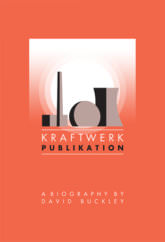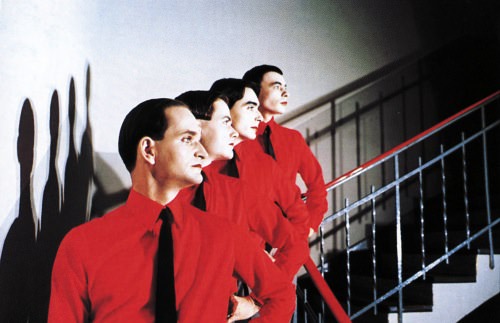A new Kraftwerk biography aims to provide the definitive account of the iconic band’s story. But does it misrepresent the group’s impact on dance music?
There are fundamental problems with the whole concept of the band biography. The best biographies are unflinching in their attempts to document both the highs and lows of their subject’s life and career, scandal and all. Many of the best also involve a degree of cooperation from their subjects. There isn’t a lot of scandal to be found in the history Kraftwerk, but the notoriously media-phobic band present their own unique set of problems when it comes to cooperation.
 Kraftwerk Publikation isn’t an authorised biography per se, but it’s the next best thing; author David Buckley enlisted the help of two of the four members of Kraftwerk’s classic lineup in the course of his research. Buckley acknowledges the fact that Ralf Hütter and Florian Schneider were the creative driving forces behind the band’s music, but the contributions of Karl Bartos and Wolfgang Flür provide genuine insight into key events in the group’s career. In spite of Hütter and Schneider’s reluctance to take part, Publikation comes close to providing a comprehensive history of Kraftwerk, their impact on music and the motivations of the key members of the group.
Kraftwerk Publikation isn’t an authorised biography per se, but it’s the next best thing; author David Buckley enlisted the help of two of the four members of Kraftwerk’s classic lineup in the course of his research. Buckley acknowledges the fact that Ralf Hütter and Florian Schneider were the creative driving forces behind the band’s music, but the contributions of Karl Bartos and Wolfgang Flür provide genuine insight into key events in the group’s career. In spite of Hütter and Schneider’s reluctance to take part, Publikation comes close to providing a comprehensive history of Kraftwerk, their impact on music and the motivations of the key members of the group.
Crucially, Buckley frames the group’s formation and early creative output in the context of post-war (West) Germany. Kraftwerk – and their contemporaries in Neu! and Can – grew up in the shadow of Nazism and inherited the shame of their parents’ and grandparents’ generations. Hans-Joachim Roedelius of Cluster recalls that the German youth of the 1960s struggled “to find their own way to express in art what was necessary at the time.”
West German baby boomers grew up in an era when the heavily damaged infrastructure of the nation was being rebuilt almost from scratch. Germany was developing one of the world’s leading manufacturing industries, making a fresh start and looking to the future. In much the same way as the industrial landscape of 1980s Detroit would play an instrumental role in defining the rhythms of early techno, Schneider and Hütter’s surroundings in Düsseldorf helped define Kraftwerk’s futuristic approach. As Buckley puts it: “The heartbeat of everyday industrial life is encoded directly in their aesthetic.”
Over the course of their creative peak from 1974 to 1982, Kraftwerk’s music was consistently ahead of its time in terms of its use of synthesised sound and computerised rhythms. Of the group’s two biggest UK hits, 1974’s ‘Autobahn’ was initially dismissed by many as a novelty record, while ‘The Model’ bubbled under as an album track and B-side for nearly four years before topping the charts in 1982.
The heartbeat
of everyday industrial life
is encoded directly in their aesthetic.
Kraftwerk’s influence on dance music is undeniable. Buckley points out that the group’s music was most influential in the years following their greatest creative period. Their influence is clearly seen in early 80s synthpop (“You can’t fully understand ‘Blue Monday’,” Buckley argues, “without sounding ideas epitomised by Kraftwerk.”) and electro, then later in house and even more so in techno.
Unfortunately, Buckley’s analysis of dance music is overly simplistic and slightly naive in places, particularly as he assumes that all dance music – from techno to Madonna – is directly rooted in Kraftwerk, with a disconnection only emerging as house and techno cross over into the mainstream in the early 1990s and “the subtleties of the Kraftwerk sound [are] debased.” While a significant proportion of dance music is clearly indebted to the group’s minimalism, mechanical rhythms and futurism, there are major exceptions. The vast majority of house music, for instance, is rooted much more clearly in the hedonism of disco and the spirituality of gospel than in the motorik modernist coldness of Kraftwerk.
The manner in which Publikation almost dismisses dance music which the author perceives to ‘debase Kraftwerk’s subtlety’ is also problematic. In tracing the group’s influence into the 1990s, Buckley describes Underworld’s ‘Born Slippy .NUXX’ as a Dionysian anthem of bliss and elation “which made you want to shout ‘lager, lager, lager'” – a commonly held but fundamentally misguided interpretation of Karl Hyde’s cry for help. Vast swathes of dystopian techno and bittersweet house owe much more to the “studied alienation” of synthpop and Kraftwerk than Buckley appears to realise.
Interpretations of dance music aside, Publikation is certainly the most comprehensive study of Kraftwerk’s career and creative output to date. In his foreword, Karl Bartos states that Publikation is “the first serious book by an outsider about the band [he] was a member of for 15 years.” It’s difficult to argue with him on that point. Pitched at a level which will suit Kraftwerk die-hards and those with only a basic knowledge of the group’s history, Publikation is a compelling account of this unique band’s story.
